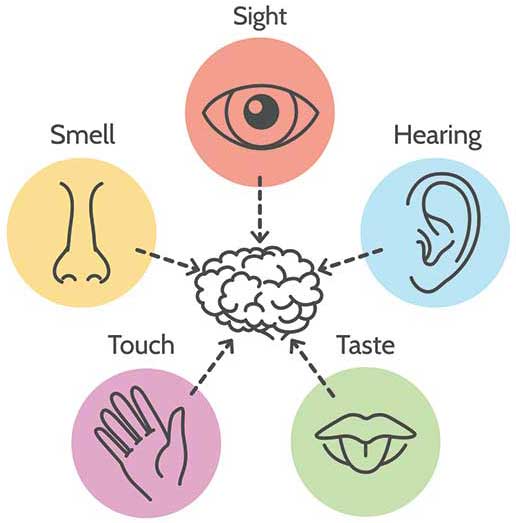Principle 6 of Intuitive Eating truly falls under the question: What do you really want to eat? Not what diet culture tells you, but what do you truly desire to eat when you are hungry. Of course, this can vary throughout the day! Satisfaction from food comes from what you enjoy, as well as a pleasant environment. There can be many things that contribute to your satisfaction with food, so let’s get into it!
Our food satisfaction comes from the texture, smell, temperature, and sights of our food. Of our senses, we have foods that we have preferences or dislikes for. It is mindful to consider that these tastes or other senses can change over time.1 As time went on, you may have had a previously disliked food but now like it. This comes with time, different experiences, and more. For me, I did not like onions growing up. As I got older, and happened to go to a taco restaurant that had an onion and cilantro mixture on the tacos, I ended up really liking it. Now, I add them any chance I get! Tomatoes are a food that I have not liked before and still don’t, and that is okay!
What foods have you previously disliked, but like now?
Diving into our senses
Texture has the power to influence our satisfaction with a meal. Were you expecting and looking forward to a crunch in your food, but received the opposite? Maybe you want something that is smooth. You may even want something that has a variety of textures.
Some other textures you may think about and can be more appealing depending on the time of the day and other factors are moist, thick, sticky, mushy, crispy, dry, lumpy, and more!
The given flavors we taste come with the assistance of our sense of smell. When something smells appealing to us, we tend to have satisfaction with that food, especially if you find it to be tasty. With that, the aroma released from cooking may increase the satisfaction of that food. Even something as simple as adding cinnamon, for example, to a coffee can increase that appeal.
Temperature has an influence as well. Maybe it is warm outside and you’re hungry for a snack, so you make a smoothie (something cold). Or, it is cold outside and you’re hungry for dinner – maybe soup sounds appealing.
Even our sights of food can have an influence as well. Foods can look unappealing to us as well, leading us to feel unsatisfied from the start. For example, the golden brown color to baked foods may look so much more appealing to people, especially if the food is typically prepared that way. To add on, even our environment can play a role in our appeal to food. Maybe sitting at a clean kitchen table that is decorated with a vase of flowers can help you savor your meal.
We can keep in mind the nutrient density of foods. Maybe you want something that is colorful, filling, and nutrient dense; or something that is light such as popcorn or yogurt. This is another reason to cue into our hunger/fullness cues to get in a sense of how hungry we are.
When keeping our sensory evaluations in mind, we can unlock complete satisfaction in our meals.

Nutrient-dense or healthy foods
Some individuals have a hard time incorporating nutrient dense foods such as fruits, vegetables, and whole grains into their diet. Some may not enjoy many of these foods, and/or others eat them while restricting other foods that they like such as pizza (diet mentality). Individuals have different goals and adjustments to be made to increase their satisfaction in their meals.
Some individuals may want to increase more vegetables into their diet. There can be different ways to go about doing this, but over time it can become easier to incorporate nutrient-dense foods when we discover different ways to prepare them for our satisfaction. With that, this can involve keeping in mind what we want, even if that is pizza, donuts, etc. We have the ability to increase the nutrient density in these foods if we are able to. Not every meal needs a fruit or vegetable, but if you are someone who would like to intake more vegetables, you can pair them with other foods and/or cook them. For example, someone may love pizza and find that they still like it when they add peppers to it and the flavor peppers produce on pizza (I love the flavor of green peppers on pizza).
Another example would be this same individual who wants mac and cheese for lunch. They may decide to add broccoli, which increases color and adds a little bit of fiber. Or instead, maybe they drizzle some olive oil and seasonings on it to bake in the oven.
You may have a different way of increasing nutrients in your meals. Individuals who eat very little to no fruits and vegetables may have a harder time including them in their diet. They may need to gradually add those foods into their meals, but in a way that they enjoy. This could be using different cooking methods, sauces, different sizing of the fruits or vegetables, etc. Another example of this would be brussel sprouts. I do not love brussel sprouts, but I could tolerate them. I wanted to make it in a way that I would enjoy them. With that, I have made a balsamic and honey dressing to toss in the brussel sprouts after they have baked. It was yummy!
These are just some examples of ways people have prepared foods in a way that they like, as well as increasing the nutrient content of their meal or snack.
There are many individuals who will restrict certain foods because they believe those foods are unhealthy. Yet, we find that this mentality cannot be realistic because it leads to a negative, cyclic cycle of being “on track” with a diet, then “failing” (constantly starting a “new” diet), but also it is not realistic because you should be able to enjoy any foods that you would like. When we cut out the food police (food rules and negative thinking about food), we increase our satisfaction. We also want to keep in mind that it may not be realistic for most to completely cut out the foods they love because you may end up eating those foods, but in a way that results in binging (maybe), emotional eating, unsatisfaction, and guiltiness. Who wants to feel that way
Ask yourself, what do I want to eat right now?
Timing
The amount of time given to eat a meal can have an impact on satisfaction from our meal. When we are eating while distracted (as talked about in principle #5), we tend to not tune into those sensory appeals that food gives us. With that, we are potentially left unsatisfied. We also may eat fast, depleting our ability to again tune into the texture, flavor, smell, temperature, and sights of our food. When we eat fast, we may reduce our ability to sense if we are too full, leading us to feel uncomfortable. There is more about hunger and fullness within the previous blog post of principle #5, “Feel your Fullness.”
To recap, diet culture has taught you that to eat “healthy” and cut out certain foods, which can typically results feeling unsatisfied. Enjoyment of food is part of the eating experience. Feeling guilty, feeling bad about eating certain foods, or restricting your food groups is not a way to live. You also do not have to consume foods that you do not like (even if that is Brussel sprouts, with a dressing on them). The goal is to eat what you love, discover new foods, and include nutrient dense foods (that you love) to live a happy, sustainable life.
